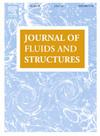Transient vortex-induced vibrations of a cylinder released from rest
IF 3.4
2区 工程技术
Q1 ENGINEERING, MECHANICAL
引用次数: 0
Abstract
The transient response of an elastically-mounted rigid cylinder released from rest in a steady freestream is investigated experimentally through simultaneous displacement and two-component velocity field measurements in conjunction with force estimation. The Reynolds number is maintained constant at 4,400, while the reduced velocity is varied between 4.5 and 11.5. The amplitude response indicates distinct transient behavior across all response branches, including a notable amplitude overshoot in the initial branch and continuous amplitude growth to quasi-steady state in the upper and lower branches. Following cylinder release, forcing is shown to transition from purely von Kármán frequency to nonlinear forcing, and comparisons to a linear oscillator show key differences in system behavior during this transition. Following lock-in, the time taken to attain quasi-steady state increases, while the maximum amplitude growth rate decreases with . The observed differences in the transient amplitude growth rate are linked to distinct changes in the forcing characteristics, primarily driven by the phase difference between forcing and cylinder displacement. The presented analysis of the transient flow development reveals a close relationship between the timing of vortex shedding and the forcing phase difference. Additionally, the mechanisms underlying the transition from initial von Kármán shedding to quasi-steady lock-in behavior, highlighted by notable changes in wake characteristics, are identified for transients in each response branch.

从静止状态释放出来的圆柱体的瞬态涡激振动
通过同时进行位移和双分量速度场测量并结合力估计,研究了在稳定自由流中从静止状态释放的弹性安装刚性圆柱体的瞬态响应。雷诺数在Re≈4400时保持恒定,而减速速度在U *≈4.5和11.5之间变化。振幅响应在所有响应分支中表现出明显的瞬态行为,包括初始分支中明显的振幅超调和上下分支中连续的振幅增长到准稳态。在气缸释放后,作用力从纯粹的von Kármán频率转变为非线性作用力,与线性振荡器的比较显示了在这种转变过程中系统行为的关键差异。锁定后,达到准稳态所需的时间增加,而最大振幅增长率随U *而减小。观察到的瞬态振幅增长率的差异与强迫特性的明显变化有关,主要是由强迫和圆柱体位移之间的相位差驱动的。通过对瞬态流动发展的分析,揭示了旋涡脱落时间与强迫相位差之间的密切关系。此外,从最初的von Kármán脱落到准稳定锁定行为的转变机制,由尾迹特征的显着变化突出,在每个响应分支中确定了瞬态。
本文章由计算机程序翻译,如有差异,请以英文原文为准。
求助全文
约1分钟内获得全文
求助全文
来源期刊

Journal of Fluids and Structures
工程技术-工程:机械
CiteScore
6.90
自引率
8.30%
发文量
173
审稿时长
65 days
期刊介绍:
The Journal of Fluids and Structures serves as a focal point and a forum for the exchange of ideas, for the many kinds of specialists and practitioners concerned with fluid–structure interactions and the dynamics of systems related thereto, in any field. One of its aims is to foster the cross–fertilization of ideas, methods and techniques in the various disciplines involved.
The journal publishes papers that present original and significant contributions on all aspects of the mechanical interactions between fluids and solids, regardless of scale.
 求助内容:
求助内容: 应助结果提醒方式:
应助结果提醒方式:


